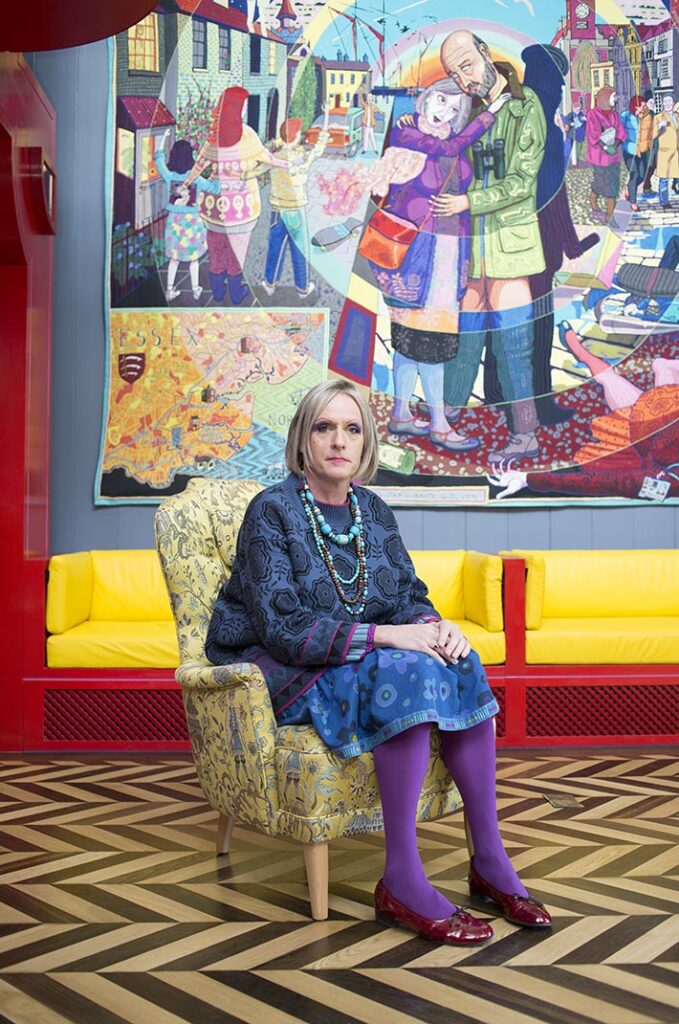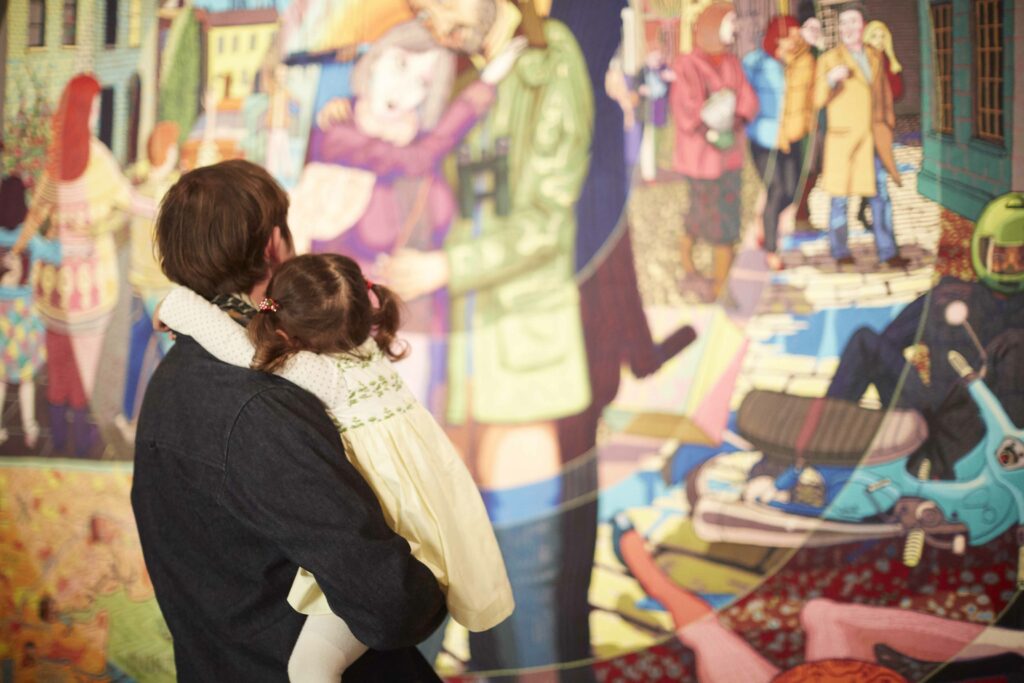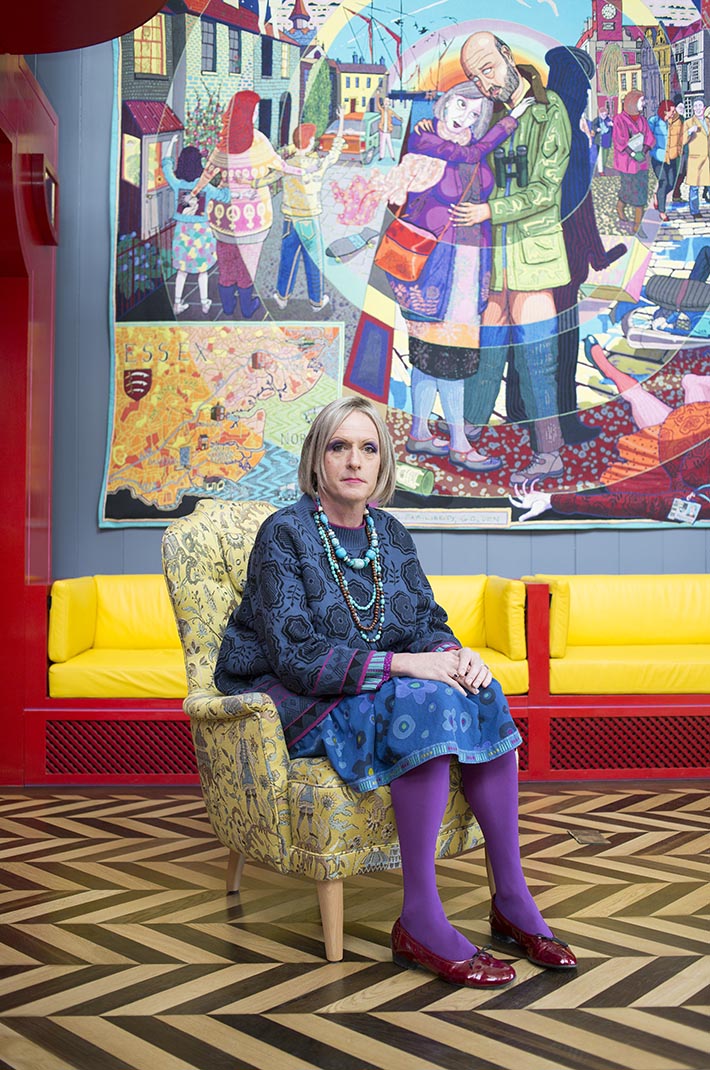Written for Good on Paper magazine

Grayson Perry hardly needs an introduction. National treasure and arbiter for social anthropology in our troubled times, Perry is one of Britain’s most famous living artists (alongside David Hockney of course.) He was awarded a CBE in 2014, the Turner Prize in 2003, is a Bafta Award winner, ceramicist turned television presenter – oh, and he likes wearing a dress!
He is currently exhibiting The Most Popular Exhibition Ever! at The Serpentine Gallery in parallel with this exhibition – a diptych of jacquard tapestries at New Brewery Arts Centre in Cirencester. Far from being ‘out in the sticks’ the Cotswolds and – more specifically – New Brewery Arts, led by their ambitious CEO Beth Alden, had the vision to bring this touring Crafts Council exhibition right to our doorstep. Indeed, there are already links with the Essex born artist, who opened the newly refurbished arts centre in 2008. And yes, he came as his alter-ego, Claire, and was wearing his Alice in Wonderland dress and peep toe shoes.
Who is Julie Cope?
The fictional character, Julie Cope, is at the centre of these works, designed and made for The Essex House Tapestries, acquired by the Crafts Council Collections in 2017 and now touring the UK. They tell the story of her life – she is an ordinary Essex everywoman and seen through Perry’s eyes she is a heroic figure. She represents all women – your mother, sister, friend – but also the narrative of an average life, full of trials, tribulations, mistakes and regret. The tapestries detail the story of Julie’s life in two parts, with many obvious and more hidden social references, documenting her modest beginnings, her rise in social standing through to her final demise at the hands of a bike courier. It’s witty and tragic but ultimately positive – Julie overcomes her limitations and finds happiness and true love.

New Brewery Arts, Cirencester, capture this wonderful exhibition as it goes on tour
Every detail of this exhibition has been carefully considered, from the vibrant entrance banner, instructions on how to social media share: hashtag #juliecope #graysonperry #newbreweryarts, multiple information panels and the dulcet tones of Grayson himself reading the Ballad of Julie Cope to accompany the experience. There’s a guide for young visitors (complete with spy holes and a quiz) and plenty of merchandise to round off your visit. It’s commercial, accessible and unpretentious. It is exactly what Perry strives to achieve in all his work, “to widen the audience for art without dumbing it down.”
The cool, dark exhibition space is a welcome retreat from this week’s heat wave. It’s a quiet cave, a place to sit, listen and reflect – a monument to a life. What would two tapestries say about my life?

Essex folk
What I find interesting and frankly impressive is the scale of this concept – it’s a three dimensional novel.Having created his muse, Julie Cope, the project has grown to include the building of a large chapel on the Stour Estuary at Wrabness. It’s the artist’s most ambitious project yet, on one level it is a temple to Julie, built by loving husband Rob, but also serves as a tribute to all the Essex folk that Perry grew up with. When the tour is finished, the tapestries will return to Wrabness and will always be viewed in this setting. It’sboth genius and weirdly curious.
Perry has created a virtual life complete with social, political and economic identity. Julie had hopes and dreams, she did her best and made mistakes along the way – just like the rest of us. Perry details where she smoked her first cigarette as teenager, her parents Norman and June, the arrival of her daughter Elaine, Dave’s affair with Pam…..the layers in this story are staggering.Julie is a tool for a wider conversation about social mobility, personal identities, “I investigate our slippery sense of who we feel we are….the ongoing process of “being ourselves”.
Friends all agreed they were “A Perfect Match”
The first tapestry details Julie’s birth during the Canvey Island floods of 1953, her teenage years hanging out in Basildon, the birth of her children with her first husband Dave. It’s a deceptive portrait of the perfect aspirational family, but there are symbols and clues which point to the breakdown of their marriage. Look out for Pam, the cat, a dual reference to the popular Lloyd Webber musical popular at the time and the name of Dave’s lover. Alan Measles, his childhood teddy bear, makes an appearance and represents the only constant male figure in Perry’s life after his parents’ divorce and his mother’s subsequent affair with the abusive milkman (a cliché that Perry could never overcome.)

In Its Familiarity, Golden
In this second tapestry, Julie has developed into a mature woman with a good job and wider horizons. She’s moved to Maldon, her children are at university and she’s found Rob, “exotic, a gent with nothing to prove to other men.” It’s all going swimmingly until she is mown down by an inexperienced curry delivery driver on a moped. A tragic end to an ordinary life.
The map depicts the upward shift in Julie’s life from Canvey Island, to the high rise in Basildon, terrace and finally the cottage in provincial Maldon. Look out for symbols throughout – the Duran Duran album cover sleeve on the back of a denim jacket, peace symbols on Julie’s cardigan show her newpreoccupation with middle class ideologies, world peace, the plight of refugees. She dies aged 61, her social worker’s lanyard around her neck. In response to this tragedy, Rob promises to build a shrine to his beloved – a Taj Mahal for Essex – and so, ‘House for Essex’ is born.
Tapestry weaving – a history
Tied up in the story of Julie, Dave and Rob are historical references to the patrician art of making tapestries and the working class art of ballad-writing. Tapestry weaving saw its heyday in the 16th& 17th centuries and cost thousands of pounds, even then, meaning they were the preserve of the elite. In contrast, ballads were the cheapest and most direct way of sharing information, printed on a single sheet and pinned to the walls of the alehouse. Perry references the large tapestry maps commissioned by society gentleman Ralph Sheldon in the 1590’s – a nod to these historical documents, he hopes the Julie Cope tapestries will also be regarded as such in hundreds of years time.
The medium used to present this story is also significant in that Perry has always worked three dimensionally – using age old processes like ceramics and needlework to present modern ideas. Perry is the poster boy for contemporary craft, speaking up for the relevance of craft in the digital age – he is keen to use the latest technology to modernise his work as artists have done for centuries. The tapestries were drawn on an interactive pen display, translated into coded instructions for a digital loom by Factum Arte in Madrid, then threaded and woven by Flanders Tapestries. (The Dutch are famed for their tapestries.)
Life, love and death
Julie Cope’s Grand Tour is a continuation of the recurring themes in his work – the big questions on life, love, death of course, but predominantly social mobility which he gently scrutinises – our consumerist, social climbing society. There is focus on finding extraordinary moments in ordinary lives, how themainstream can often prove the most meaningful. I urge you to go and see the exhibition. You might not like the tapestries, you might not understand them, but they do pose important questions about our society, our identities, ambitions and purpose. It’s also really fun to see the work of a Turner Prize winning artist up close.
“Immediately after I won the Turner prize, a journalist asked me whether I was a serious artist or just a lovable character. My response was to say: “I’m both.” I don’t see them as mutually exclusive. Art can be intellectually stretching, significant, moving and fun at the same time,” Perry concludes. After all, he accepted the prize on behalf of ALL artists, for ‘thirty years of hard graft’, of sticking to his guns and plugging away…..and it paid off.
